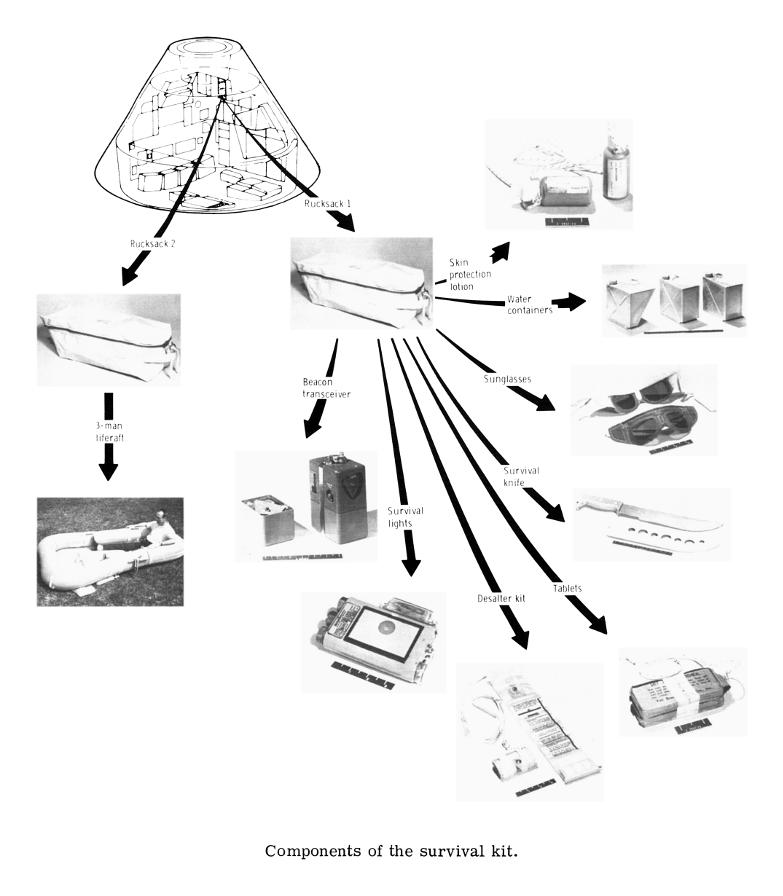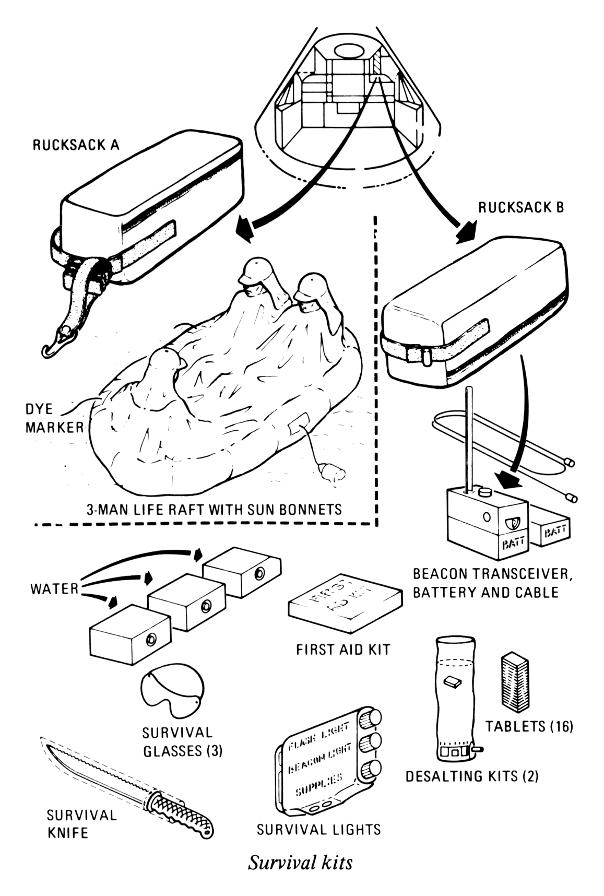Apollo Survival Kit
The Apollo command module was equipped with survival equipment designed to support the crew for three days. Although it seems inconceivable that the CM might come down in a location so remote that recovery forces would take three days to arrive, there must have been some emergency scenario which led to this requirement.
The survival equipment was stored in two rucksacks stowed in the command module's right-hand forward equipment bay. The rucksacks were 18 inches long, 6 inches wide, and 6 inches deep and weighed about 54 pounds. They were made of Armalon, a Teflon-coated glass fabric. Each bag was equipped with a zipper opening and a strap handle; the strap handle allowed for rapid removal from the stowage area and allowed handling by a single crewman in the event of a post-landing emergency. A D-ring was attached to each handle to allow the rucksack to be moored to the life raft to prevent loss.
One of the rucksacks contained a three-man rubber life raft with an inflation assembly, a carbon dioxide cylinder, a sea anchor, a dye marker, and a sunbonnet for each crewman. The other rucksack contained a beacon transceiver, survival lights, desalter kits, machete, sun glasses, three water cans, and a first aid kit.
Click image for a 4689x3333 pixel version of this image in a new window.
From an unnumbered page of the February 24, 1967 version of Apollo
Training, Apollo Spacecraft & Systems Familiarization (Course Number
APC-118), located in the heroicrelics library. A slightly later version
of that document is available in electronic format from the Apollo Lunar Surface Journal;
refer to page 180 of that PDF.
Scan and cleanup by heroicrelics.
The three-man life raft included three ballast buckets, a sea anchor, and two sea-dye markers. The dye markers were standard DOD dye markers which could turn sea water to a yellow-green color which could be recognized by recovery forces from an altitude of 5,000 feet and at a range of up to 10 miles.
The raft could be inflated by a carbon dioxide system (consisting of two carbon dioxide cylinders) or manually via an oral inflation system.
The UHF beacon transceiver (manufactured by Sperry Phoenix Co.) was a hand-held, dry-cell battery-powered radio tuned permanently to a VHF frequency of 243 megacycles, the international distress frequency. Broadcast and reception were limited to line-of-sight transmissions.
The receiver-transmitter and battery pack formed a watertight assembly about 8 by 4 1/2 by 3 inches and was equipped with a tapered, flexible steel tape antenna that could be extended to 11 1/2 inches. The transceiver unit could be used for voice communications through a speaker and microphone or as a beacon, in which case it would transmit an intermittent signal for up to 24 hours. A spare battery and a spacecraft connector cable were provided.
This original radio, designed for the Gemini program, was carried on Apollo 7 through Apollo 11, after which it was replaced with a unit developed especially for the Apollo program. Voice reception increased from approximately 30 to 120 miles. Voice modulation was improved and radio weight was reduced from 6 pounds to 4 pounds. Beacon range reception also increased to 120 nautical miles, for search aircraft operating at 10,000 feet.
Click image for a 2140x2915 pixel version of this image in a new window.
From p. 219 of the Apollo Spacecraft News Reference [Command/Service
Module], located in the Mrazek collection, Dept. of Archives/Special
Collections, M. Louis Salmon Library, University of Alabama in
Huntsville. A similar-vintage News Reference is available in
electronic format from the Apollo Lunar
Surface Journal; refer to page 233 of that PDF.
Scan and cleanup by heroicrelics.
The survival lights were contained in a waterproof, three-in-one device. The unit had a flashlight, a strobe light for night signaling, and a waterproof compartment containing a siren whistle, a compass, fire starters, cotton balls, halogen tablets, a water receptacle, knife blades, needles, nylon cord, and fishhooks. The top of the unit was a compass with a folding signal mirror on one side.
The desalter kit consisted of two processing bags, eight chemical packets, and mending tape. Each chemical packet was designed to produce 1 pint of potable water. Water was processed by mixing sea water and a chemical packet for about one hour. The mixture was then filtered to produce the drinking water, available through a valve on the bottom of the bag.
Click image for a 2149x2460 pixel version of this image in a new window.
From page 28 (page 35 in the PDF) of the Apollo Experience
Report: Crew Provisions and Equipment Subsystem.
Extraction and restoration by heroicrelics.
The survival machete was a 17-inch long knife that had an aluminum handle and a high-quality stainless steel blade with a cutting edge on one side and a sawing edge on the opposite side. The machete's sheath was fabricated from aluminum sheeting with a Teflon spacer (to protect the blade). The machete would have been used for cutting or sawing if jungle-type terrain was encountered after an emergency landing.
The light-polarizing sunglasses had soft fabric frames and were adjustable to head size and face contour. They were held against the face by lengths of elastic braid and could be fastened in back of the head with Velcro. The sunglasses were designed for compactness and to resist breakage.
Three water containers were included in the Apollo survival kit. Two of the containers were rectangular in shape while the third was triangular (to fit the available space). Each water container was made of aluminum (to meet flammability requirements) and held 4.5 pounds (a bit over a half gallon) of deionized water.
During development of the metal water containers, the largest side of the water containers would deflect considerably because of pressure differential; this problem was solved by creating a 1/4-inch-radius indention forming an "X" on each of the two largest sides. The containers originally had a press-fit stopper, which blew out during a chamber decompression test. Replacing the stopper with a screw cap solved this problem.
While it was never necessary to use the water containers during a mission, a few crewmen complained during training that the aluminum of the containers caused the water to have an unpleasant taste.
The survival medical kit contained the same type of supplies as the emergency medical kit: 6 bandages, 6 injectors, 30 tablets, and one tube of all-purpose ointment.
Finally, the survival kit contained two 2-ounce plastic squeeze bottles containing of skin protection lotion to protect against sunburn. The lotion was also water repellent.
Click image for a 2314x3432 pixel version of this image in a new window.
From p. 82 of the Apollo Spacecraft News Reference [Command/Service
Module], located in the Mrazek collection, Dept. of Archives/Special
Collections, M. Louis Salmon Library, University of Alabama in
Huntsville. A similar-vintage News Reference is available in
electronic format from the Apollo Lunar
Surface Journal; refer to page 86 of that PDF.
Scan and cleanup by heroicrelics.
The top-most graphic on this page was from early Block II command module documentation, dated January 1967. The survival kit must have not changed much between then and the first moon landing, as the diagram immediately above was from the Apollo Spacecraft News Reference issued shortly before the Apollo 11 mission. (Or, perhaps, no one ever updated the graphics :-)
The bulk of the descriptive text on this page was taken, largely verbatim, from the Apollo Experience Report: Crew Provisions and Equipment Subsystem and the Apollo Spacecraft News Reference.



